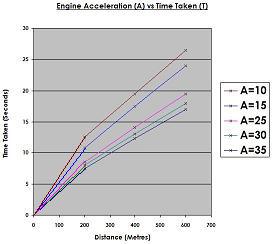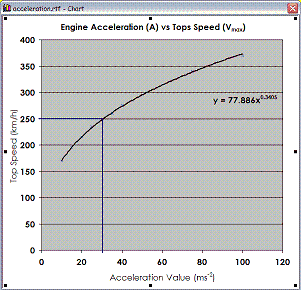Acceleration in GTA 3 & Vice City Handling
The acceleration of your car is the most important value the whole feel of its performance to many people. It potent your car will be when exiting a turn, it gives the striagt-line performance and is the most important figure to achieving those massive jumps! However, it does not use real-world units. It is not horsepower or acceleration in ms-2. Which is why I have written this, to try and make sense of it.
First Experiment
I set a car up with 1000 Mass, 1.0 Traction Multiplier and 1.0 Traction Loss and 0.50 for the Traction Bias. I used different Engine Acceleration values to see what effect it had. I took the vehicle to the runway on Shoreside Vale and timed it from a standard start to pass five, ten and fifteen lights. I measured the distance between each post as being nine car lengths. A car is around 4.5 metres long, so each post is about 40 metres apart. Therefore five posts are 200m, ten posts are 400m and fifteen posts are 600m!
400 metres is about a quarter mile, so if you know the time the car takes for a standing quarter mile you can find the rough engine acceleration value from this graph:
Assuming your car takes fifteen seconds to do a standing quarter mile, it will take fifteen seconds to reach the middle set of readings taken at 400 metres. So find the fifteen second mark and look across until you are vertically in line with the 400 metre mark along the bottom. You will find yourself a little above the pink line. This means that the Engine Acceleration you would need is probably between 15 and 25, perhaps nearer to 25.
That is the sort of way this works; you cannot get exact values because your car may be heavier than 1000 or have lower traction settings. You need a bit of intuition to work out quite what settings you need. Of course, you could just set it pretty close to the value this graph says, then test it by timing how long it takes for a standing start to get past ten of the posts on the runway on Shoreside Vale!
Second Experiment
GTA 3 and GTA Vice City use a very simple physics which limits top speed. Because of this, the outright top speed of a car will be less than you would expect from the Engine Acceleration value and, furthermore, does NOT rely on the Top Speed paramater. Honestly!
The below graph shows the top speeds reached by a vehicle when using Engine Acceleration values of 10, 15, 25, 30, 35, 40, 45, 50, 75 and then 100.
The blue lines on the image above demonstrate the technique best. To find the acceleration value you need to reach a certain speed, locate that speed on the vertical axis. If we choose 250km/h then we see there is a blue line drawn horizontally until it hits the graph curve. It then runs straight downward from that point and hits the horizontal axis at about 30. Therefore, to reach a top speed of 250km/h you need an Engine Acceleration value of about 30.
You may also notice that you can pick an Engine Acceleration value and follow the line in the opposite direction to find what speed it will achieve. Top speed does not rely on anything other than acceleration. However, you can electronically limit it by setting the top speed parameter to less than the outright top speed. For instance, you could limit a car with an acceleration of 30 to a top speed of 200km/h but could not boost its top speed to 350km/h.

